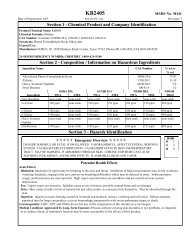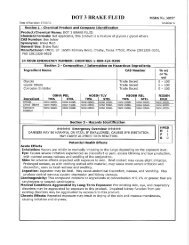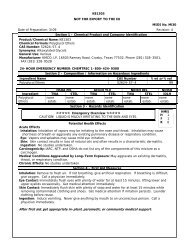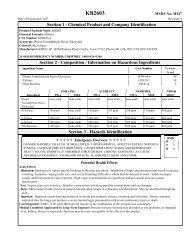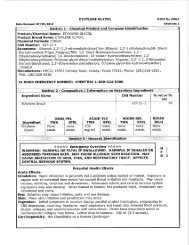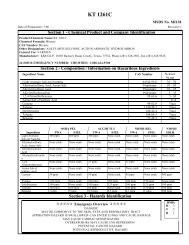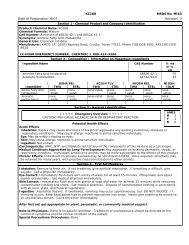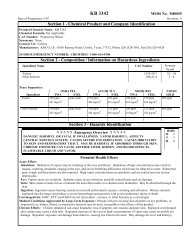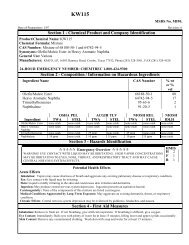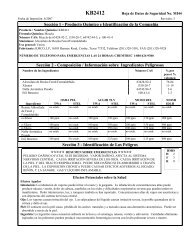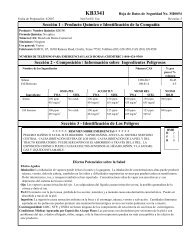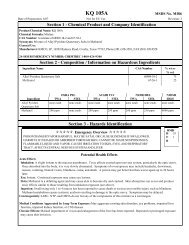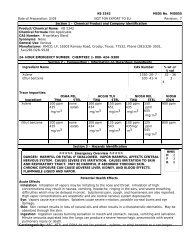You also want an ePaper? Increase the reach of your titles
YUMPU automatically turns print PDFs into web optimized ePapers that Google loves.
Revision: 5 <strong>KB</strong> <strong>3341</strong> Revision Date: 6/07<br />
Eye Effects: Vapors cause eye irritation.<br />
Splashes cause severe irritation, possible<br />
corneal burns and eye damage.<br />
Skin Effects: Skin contact results in loss of<br />
natural oils and often results in a characteristic<br />
dermatitis. May be absorbed through the skin.<br />
Section 11- Toxicological Information<br />
Toxicity Data: *<br />
Acute Inhalation Effects:<br />
Rat, LC 50 (xylene): 5000 ppm / 4H<br />
Acute Oral Effects:<br />
Rat, oral, LD 50 (xylene) : 4300 mg/kg<br />
Rat, oral, LD 50 (ethyl benzene): 3500 mg/kg<br />
Chronic Effects: Repeated exposure can damage bone marrow and<br />
may damage the liver and kidneys.<br />
Carcinogenicity: Not Classifiable as to Human Carcinogenicity<br />
Teratogenicity: May cause teratogenic effects.<br />
* See NIOSH, RTECS, for additional toxicity data.<br />
Section 12 - Ecological Information<br />
Ecotoxicity: For xylene: This material is expected to be slightly toxic to aquatic life. The LC50/96-hour values for fish are<br />
between 10 and 100 mg/L.<br />
Environmental Fate: For xylene: When released into the soil, this material may evaporate to a moderate extent. When<br />
released into the soil, this material is expected to leach into groundwater. When released into the soil, this material may<br />
biodegrade to a moderate extent. When released into the air, this material may be moderately degraded by reaction with<br />
photochemically produced hydroxyl radicals. When released into the water, this material may evaporate to a moderated extent.<br />
Environmental Degradation: This material is not expected to bioacummulate.<br />
Section 13 - Disposal Considerations<br />
Whatever cannot be saved for recovery or recycling should be disposed of in an approved waste facility, in accordance with<br />
Federal, State/Provincial and Local requirements. May be a RCRA hazardous waste due to the ignitability characteristic.<br />
Section 14 - Transport Information<br />
Shipping Name: Flammable<br />
Liquid, n.o.s. (contains xylenes,<br />
ethyl benzene)<br />
Hazard Class: 3<br />
ID No.: UN 1993<br />
Packing Group: III<br />
Label: 3, Flammable Liquid<br />
Special Provisions (172.102):<br />
none<br />
DOT Transportation Data (49 CFR 172.101):<br />
Packaging Authorizations<br />
a) Exceptions: 173150<br />
b) Non-bulk Packaging: 173.203<br />
c) Bulk Packaging: 173.242<br />
Section 15 - Regulatory Information<br />
Quantity Limitations<br />
a) Passenger, Aircraft, or Railcar: 60L<br />
b) Cargo Aircraft Only: 220L<br />
Vessel Stowage Requirements<br />
a) Vessel Stowage: Location A<br />
EPA Regulations:<br />
RCRA Hazardous Waste Number (40 CFR 261.33): U239 (contains xylenes)<br />
RCRA Hazardous Waste Classification (40 CFR 261): Ignitable (contains xylenes)<br />
CERCLA Hazardous Substance (40 CFR 302.4) listed specific per RCRA, Sec. 3001; CWA, Sec. 311 (b)(4); CWA, Sec.<br />
307(a), CAA, Sec. 112 (contains xylenes, ethylbenzene)<br />
CERCLA Reportable Quantity (RQ) (40 CFR 302.4): Xylene, 100 lbs; Ethylbenzene, 1000 lbs.<br />
SARA 311/312 (40 CFR 370) Codes: Acute Health, Chronic Health, Fire Hazard (1,3,4) [contains xylenes]<br />
SARA 313 Toxic Chemical (40 CFR 372.65): Listed effective 1/1/87 (xylenes)<br />
SARA 304 EHS (Extremely Hazardous Substance) (40 CFR 355): Not listed<br />
OSHA Regulations:<br />
Air Contaminant (29 CFR 1910.1000, Table Z-1): Xylene 100 ppm, Ethylbenzene 100 ppm<br />
OSHA Specifically Regulated Substance (29CFR 1910): Not listed<br />
California Proposition 65 ingredients:<br />
Ethylbenzene<br />
4 of 5



